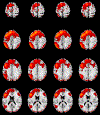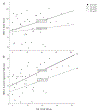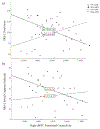Age Group Differences in Executive Network Functional Connectivity and Relationships with Social Behavior in Men with Autism Spectrum Disorder
- PMID: 32405319
- PMCID: PMC7220036
- DOI: 10.1016/j.rasd.2019.02.008
Age Group Differences in Executive Network Functional Connectivity and Relationships with Social Behavior in Men with Autism Spectrum Disorder
Abstract
Background: Research suggests adults with autism spectrum disorder (ASD) may use executive functions to compensate for social difficulties. Given hallmark age-related declines in executive functioning and the executive brain network in normal aging, there is concern that older adults with ASD may experience further declines in social functioning as they age. In a male-only sample, we hypothesized: 1) older adults with ASD would demonstrate greater ASD-related social behavior than young adults with ASD, 2) adults with ASD would demonstrate a greater age group reduction in connectivity of the executive brain network than neurotypical (NT) adults, and 3) that behavioral and neural mechanisms of executive functioning would predict ASD-related social difficulties in adults with ASD.
Methods: Participants were a cross-sectional sample of non-intellectually disabled young (ages 18-25) and middle-aged (ages 40-70) adult men with ASD and NT development (young adult ASD: n=24; middle-age ASD: n=25; young adult NT: n=15; middle-age NT: n=21). We assessed ASD-related social behavior via the self-report Social Responsiveness Scale-2 (SRS-2) Total Score, with exploratory analyses of the Social Cognition Subscale. We assessed neural executive function via connectivity of the resting-state executive network (EN) as measured by independent component analysis. Correlations were investigated between SRS-2 Total Scores (with exploratory analyses of the Social Cognition Subscale), EN functional connectivity of the dorsolateral prefrontal cortex (dlPFC), and a behavioral measure of executive function, Tower of London (ToL) Total Moves.
Results: We did not confirm a significant age group difference for adults with ASD on the SRS-2 Total Score; however, exploratory analysis revealed middle-age men with ASD had higher scores on the SRS-2 Social Cognition Subscale than young adult men with ASD. Exacerbated age group reductions in EN functional connectivity were confirmed (left dlPFC) in men with ASD compared to NT, such that older adults with ASD demonstrated the greatest levels of hypoconnectivity. A significant correlation was confirmed between dlPFC connectivity and the SRS-2 Total Score in middle-age men with ASD, but not young adult men with ASD. Furthermore, exploratory analysis revealed a significant correlation with the SRS-2 Social Cognition Subscale for young and middle-aged ASD groups and ToL Total Moves.
Conclusions: Our findings suggest that ASD-related difficulties in social cognition and EN hypoconnectivity may get worse with age in men with ASD and is related to executive functioning. Further, exacerbated EN hypoconnectivity associated with older age in ASD may be a mechanism of increased ASD-related social cognition difficulties in older adults with ASD. Given the cross-sectional nature of this sample, longitudinal replication is needed.
Keywords: Aging; Autism Spectrum Disorder; Executive Functions; Executive Network; Social Behavior; fMRI.
Conflict of interest statement
Conflict of Interest The authors of this study have no financial, personal, or other relationships that may pose a potential conflicts of interest related to this research.
Figures




References
-
- American Pychological Association. (2013). Diagnostic and statistical manual of mental disorders (5th editio). Washington, DC.
-
- Baron-Cohen S, Wheelwright S, Skinner R, Martin J, & Clubley E. (2001). The Autism Spectrum Quotient : Evidence from Asperger syndrome/high functioning autism, males and females, scientists and mathematicians. Journal of Autism and Developmental Disorders, 31(1), 5–17. 10.1023/A:1005653411471 - DOI - PubMed
Grants and funding
LinkOut - more resources
Full Text Sources
Research Materials
